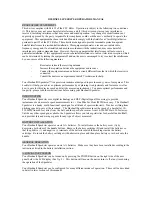
SMARTNET/SMARTZONE/P25 TRUNKED FEATURES
47
press the PTT switch and begin speaking as with a
standard call.
3. All group calls which follow are then emergency
calls (private, telephone, and call alert calls are not
allowed). If the channel is changed, the call is made
on the emergency talk group programmed for the
new channel. If the Surveillance Mode is enabled
(see Section 4.9), all indicators, lights, and tones are
disabled. If “No Receive Activity During Emer-
gency” is programmed, receive audio, the front
panel LED, and receive icons are disabled in the
receive mode (firmware Versions 1.28/2.6/3.6/4.2
or later only).
4. To exit this mode, cycle radio power or press and
hold* the Emergency switch.
6.11 FAILSOFT OPERATION
If a failure occurs in the SMARTNET/Smart-
Zone or P25 Trunked system so that it cannot be used,
the system directs the radio to automatically enter the
failsoft mode. When in this mode, “FAILSOFT” and
the alias of the selected channel are alternately
displayed. A failsoft tone may also be heard,
depending on how the repeater is programmed.
When in the failsoft mode, operation is in the
conventional mode on the preprogrammed failsoft
channel (a different failsoft channel can be
programmed on each talk group). If a transmission is
attempted before a failsoft channel is located, a contin-
uous tones sounds until the PTT switch is released.
When the radio system returns to normal operation,
this is automatically detected and normal operation
resumes.
6.12 SMARTNET/SMARTZONE/P25 TRUNKED
SCANNING FEATURES
6.12.1 GENERAL
Scanning on a SMARTNET/Smartzone or P25
Trunked system is called Priority Monitor Scan. The
following are unique features of this type of scanning.
For general scanning information applicable to all oper-
ating modes, refer to Sections 4.11 and 4.12
•
Scanning is turned on and off by the SCAN option
switch. Talk groups (channels) can be programmed
so that scanning automatically starts whenever the
talk group is selected (Autoscan).
•
When responding to calls in the scan mode, the
programming of the Talkback Scan parameter deter-
mines if a response always occurs on the talk group
of the call (Active Group) or the Selected Group if
they are different. Transmissions at other times
always occur on the selected talk group.
•
Up to 256 scan lists or the number that fit in avail-
able memory can be programmed. Each list can
include up to 256 talk groups from the same system,
one of which can be a priority group as described in
the next section.
•
If the
SCN ED
option key is programmed, scan lists
are user programmable (see Section 6.12.3). In addi-
tion, nuisance channels can be temporarily deleted
as described in Section 4.11.6.
•
Each talk group is programmed to select one of the
programmed scan lists or “No List” (scanning is
disabled). If scanning is enabled and the selected
channel does not permit scanning, it is automatically
enabled again when a channel is selected that
permits scanning.
•
The selected scan list can be temporarily changed if
the Scan (List) Select option switch is programmed.
The procedure is described in Section 6.12.3.
•
In addition to calls on channels in the scan list,
pages, private/unit calls, and telephone calls are
received while scanning. Private and telephone calls
are not interrupted by priority messages.
6.12.2 PRIORITY TALK GROUP SAMPLING
One talk group in the scan list can be designated a
priority talk group by programming or it can be the
selected talk group. When scanning, messages on a
non-priority talk group are interrupted by messages on
the priority talk group. Priority scanning must also be
supported at the system level for it to occur as
programmed in the radio.
*
This feature requires firmware 1.24.1/2.2.1/3.2.1/4.2
or later.
















































